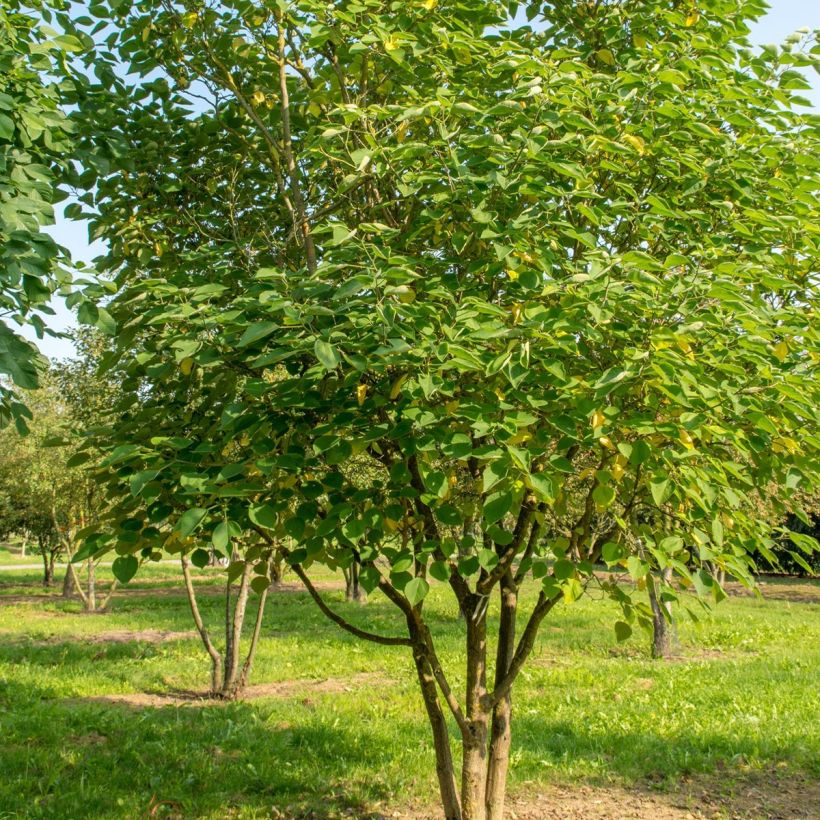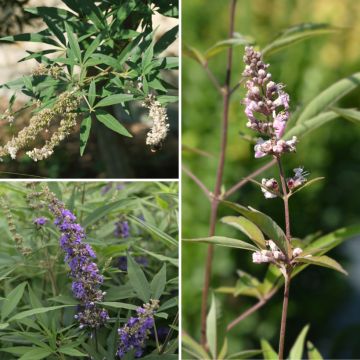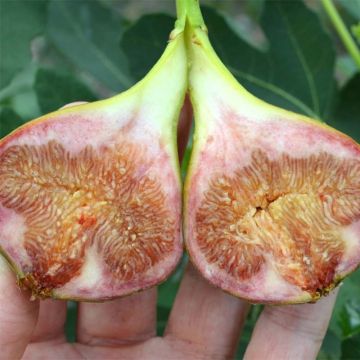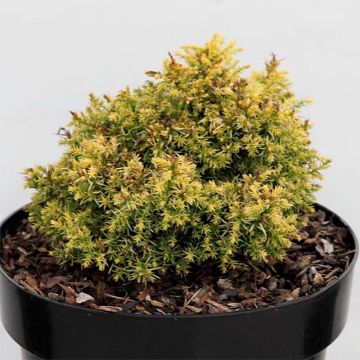

Broussonetia papyrifera - Mûrier de Chine ou à papier


Broussonetia papyrifera - Mûrier de Chine ou à papier


Broussonetia papyrifera - Mûrier de Chine ou à papier


Broussonetia papyrifera - Mûrier de Chine ou à papier


Broussonetia papyrifera - Mûrier de Chine ou à papier
Broussonetia papyrifera
Broussonetia papyrifera
Paper Mulberry
For an ecological gesture: especially do not plant, this plant is invasive. Without planting it, it arrived at my parents' house in Hérault and for 10 years we have been unable to get rid of it, there is always a shoot coming out. Moreover, it should be known that in Switzerland, it is forbidden to plant it, as it is considered dangerous for biodiversity, and can also cause allergies (pollen). Additional documentation: infoflora.ch
Evelyne, 22/08/2024
Special offer!
Receive a €20 voucher for any order over €90 (excluding delivery costs, credit notes, and plastic-free options)!
1- Add your favorite plants to your cart.
2- Once you have reached €90, confirm your order (you can even choose the delivery date!).
3- As soon as your order is shipped, you will receive an email containing your voucher code, valid for 3 months (90 days).
Your voucher is unique and can only be used once, for any order with a minimum value of €20, excluding delivery costs.
Can be combined with other current offers, non-divisible and non-refundable.
Why not try an alternative variety in stock?
View all →This plant carries a 24 months recovery warranty
More information
We guarantee the quality of our plants for a full growing cycle, and will replace at our expense any plant that fails to recover under normal climatic and planting conditions.
Would this plant suit my garden?
Set up your Plantfit profile →
Description
Broussonetia papyrifera carries many common names such as Chinese mulberry, Spanish mulberry, paper mulberry or even deer tree. Names that are found in multiple languages, as numerous as the regions of the world that have welcomed this great traveler from Asia. Its large lobed leaves, of variable shape, remind us that it is related to both the fig tree and our silk mulberries. The female trees bear globular inflorescences in the form of light red pompoms, which will produce edible fruits after pollination by a male subject. It is a small deciduous tree with a tropical appearance, but of great robustness. Its dimensions are easily controlled by pruning the young shoots, which allows it to be planted in cold regions in a large pot on the terrace or in a shrub bed.
The Chinese mulberry belongs to the family Moraceae, just like our black mulberry (Morus nigra) and white mulberry (Morus alba), and produces latex in its tissues, like all members of its family. Originally from temperate and subtropical regions of Southeast Asia, particularly China, Japan, and Polynesia, it has long been cultivated for the production of high-quality paper in its countries of origin. This small tree with a spreading and irregular habit has a slightly suckering stump, capable of producing suckers. It often grows with multiple stems, each supporting a spreading umbrella-shaped crown. Its growth is rapid during the first years, then slows down. It can reach 8-10m (26ft 2in-32ft 10in) in all directions in our favourable climates, but it is often pruned in spring, which allows it to be shaped into a large shrub not exceeding 2 to 3m (6ft 7in to 9ft 10in) in all directions. Broussonetia papyrifera is a dioecious plant, meaning that there are male individuals distinct from female individuals.
A female subject will only bear fruit in the presence of another paper mulberry carrying male flowers recognizable by being gathered in pendant catkins, 3 to 10cm (1.2 to 3.9in) long and grey-blue in colour. The bark of the paper mulberry is grey-beige, slightly striate. The young branches are pubescent, grey-green in colour. The leaves are polymorphous, meaning that their appearance can vary depending on their position on the branches. They are cordate or deeply lobed, with 3 to 7 lobes resembling the shape of an ace of spades. Rough on the surface, velvety on the underside, finely toothed at the edges, they measure 7 to 20cm (2.8 to 7.9in) in all directions. The colour of the foliage is dark green, then it turns a warm and deep yellow before falling in autumn. Flowering takes place in May-June. On female plants, it consists of globular inflorescences composed of tiny green flowers that turn red. When pollinated, they produce round fruits, 2 to 3cm (0.8 to 1.2in) in diameter, red-orange in colour, edible, juicy, and sweet, but fragile. They are a treat for humans, but also for birds that contribute to the tree's dispersal in favorable climates. Its root system, both taproot and spreading, does not tolerate transplanting well. Its strength implies that it should be planted at a respectable distance from buildings.
Morus papyrifera is capable of regenerating from the stump below -12°C. It is not demanding on soil type, and tolerates the presence of limestone, as well as poor and sandy soils. It is an excellent ground shrub for dry, Mediterranean or mild Atlantic gardens. However, it should be avoided to plant it directly exposed to sea spray. It tolerates pollution well, which allows it to be adopted in small urban gardens, better protected from severe frost. Traditionally used as a standalone plant for the beauty of its foliage, it can also be planted in a large container on a well-sheltered terrace. It is also useful on slopes to combat soil erosion. In a large exotic bed, it can be associated, for example, with Tetrapanax papyrifera, banana trees, Beschorneria yuccoides, Melianthus major, Chamaerops humilis, Cordylines, Agaves, or Yuccas. As an architectural and structural plant, it can also mark a pathway or indicate the entrance of a house.
Report an error about the product description
Broussonetia papyrifera in pictures








Plant habit
Flowering
Foliage
Safety measures
Botanical data
Broussonetia
papyrifera
Moraceae
Paper Mulberry
Cultivar or hybrid
Phytophotodermatoses
Cette plante peut provoquer l'apparition de réactions cutanées indésirables en cas de contact suivi d'une exposition au soleil.
Ne la plantez pas là où de jeunes enfants peuvent évoluer. Evitez l'exposition au soleil après l'avoir manipulée. Evitez tout contact avec la peau: privilégiez l'emploi de gants pour la manipuler. En cas de contact, lavez-vous soigneusement les mains et rincez abondamment à l'eau la zone concernée. Lavez les vêtements entrés en contact. En cas de réaction cutanée, contactez votre médecin ou le centre antipoison le plus proche de chez vous. En cas d'atteinte étendue, appelez sans tarder le 15 ou le 112.Pensez à conserver l'étiquette de la plante, à la photographier ou à noter son nom, afin de faciliter le travail des professionnels de santé.
Davantage d'informations sur https://plantes-risque.info
atteinterespiratoire
Cette plante peut entraîner des symptômes allergiques.
Evitez de la planter si vous ou vos proches souffrez de rhinite saisonnière ("rhume des foins").
Davantage d'informations sur https://plantes-risque.info
Other Shrubs A to Z
View all →Planting and care
Broussonetia papyrifera is preferably planted in spring in regions with limited hardiness or in autumn in hot and dry climates, in a well-drained and sufficiently deep soil. While it thrives faster in fertile and moist soil, it tolerates perfectly poor, calcareous or sandy, poor and dry soils in summer. Plant it in a sunny location, at least part of the day. Be careful not to damage its fleshy and brittle roots during planting. Hardy up to -12°C (10.4 °F), or even lower, it is common for it to regrow from the slightly suckering stump in spring if it has been cut back by the cold. This paper mulberry tolerates pruning well. Always intervene on young, still thin stems, and make clean and sharp cuts with a well-sharpened secateurs, supporting the upper part of the stem while cutting lower down. This way, we avoid the bark from fraying into shreds, creating large wounds that are open doors to diseases. The wood of this mulberry, very brittle, implies that a sheltered location is chosen for it, away from the wind, which could damage the foliage.
Planting period
Intended location
Care
-
, onOrder confirmed
Reply from on Promesse de fleurs
Similar products
Haven't found what you were looking for?
Hardiness is the lowest winter temperature a plant can endure without suffering serious damage or even dying. However, hardiness is affected by location (a sheltered area, such as a patio), protection (winter cover) and soil type (hardiness is improved by well-drained soil).

Photo Sharing Terms & Conditions
In order to encourage gardeners to interact and share their experiences, Promesse de fleurs offers various media enabling content to be uploaded onto its Site - in particular via the ‘Photo sharing’ module.
The User agrees to refrain from:
- Posting any content that is illegal, prejudicial, insulting, racist, inciteful to hatred, revisionist, contrary to public decency, that infringes on privacy or on the privacy rights of third parties, in particular the publicity rights of persons and goods, intellectual property rights, or the right to privacy.
- Submitting content on behalf of a third party;
- Impersonate the identity of a third party and/or publish any personal information about a third party;
In general, the User undertakes to refrain from any unethical behaviour.
All Content (in particular text, comments, files, images, photos, videos, creative works, etc.), which may be subject to property or intellectual property rights, image or other private rights, shall remain the property of the User, subject to the limited rights granted by the terms of the licence granted by Promesse de fleurs as stated below. Users are at liberty to publish or not to publish such Content on the Site, notably via the ‘Photo Sharing’ facility, and accept that this Content shall be made public and freely accessible, notably on the Internet.
Users further acknowledge, undertake to have ,and guarantee that they hold all necessary rights and permissions to publish such material on the Site, in particular with regard to the legislation in force pertaining to any privacy, property, intellectual property, image, or contractual rights, or rights of any other nature. By publishing such Content on the Site, Users acknowledge accepting full liability as publishers of the Content within the meaning of the law, and grant Promesse de fleurs, free of charge, an inclusive, worldwide licence for the said Content for the entire duration of its publication, including all reproduction, representation, up/downloading, displaying, performing, transmission, and storage rights.
Users also grant permission for their name to be linked to the Content and accept that this link may not always be made available.
By engaging in posting material, Users consent to their Content becoming automatically accessible on the Internet, in particular on other sites and/or blogs and/or web pages of the Promesse de fleurs site, including in particular social pages and the Promesse de fleurs catalogue.
Users may secure the removal of entrusted content free of charge by issuing a simple request via our contact form.
The flowering period indicated on our website applies to countries and regions located in USDA zone 8 (France, the United Kingdom, Ireland, the Netherlands, etc.)
It will vary according to where you live:
- In zones 9 to 10 (Italy, Spain, Greece, etc.), flowering will occur about 2 to 4 weeks earlier.
- In zones 6 to 7 (Germany, Poland, Slovenia, and lower mountainous regions), flowering will be delayed by 2 to 3 weeks.
- In zone 5 (Central Europe, Scandinavia), blooming will be delayed by 3 to 5 weeks.
In temperate climates, pruning of spring-flowering shrubs (forsythia, spireas, etc.) should be done just after flowering.
Pruning of summer-flowering shrubs (Indian Lilac, Perovskia, etc.) can be done in winter or spring.
In cold regions as well as with frost-sensitive plants, avoid pruning too early when severe frosts may still occur.
The planting period indicated on our website applies to countries and regions located in USDA zone 8 (France, United Kingdom, Ireland, Netherlands).
It will vary according to where you live:
- In Mediterranean zones (Marseille, Madrid, Milan, etc.), autumn and winter are the best planting periods.
- In continental zones (Strasbourg, Munich, Vienna, etc.), delay planting by 2 to 3 weeks in spring and bring it forward by 2 to 4 weeks in autumn.
- In mountainous regions (the Alps, Pyrenees, Carpathians, etc.), it is best to plant in late spring (May-June) or late summer (August-September).
The harvesting period indicated on our website applies to countries and regions in USDA zone 8 (France, England, Ireland, the Netherlands).
In colder areas (Scandinavia, Poland, Austria...) fruit and vegetable harvests are likely to be delayed by 3-4 weeks.
In warmer areas (Italy, Spain, Greece, etc.), harvesting will probably take place earlier, depending on weather conditions.
The sowing periods indicated on our website apply to countries and regions within USDA Zone 8 (France, UK, Ireland, Netherlands).
In colder areas (Scandinavia, Poland, Austria...), delay any outdoor sowing by 3-4 weeks, or sow under glass.
In warmer climes (Italy, Spain, Greece, etc.), bring outdoor sowing forward by a few weeks.




























































